Sarah Sundin's Blog, page 174
February 19, 2020
Today in World War II History—February 19, 1940 & 1945

Men of USMC 5th Division advancing through the volcanic ash hills of Red Beach No. 1 at Iwo Jima, 19 Feb 1945 (US Naval History and Heritage Command)
80 Years Ago—February 19, 1940: José Estigarribia, President of Paraguay, suspends the constitution, dissolves the legislature, and enacts authoritarian rule.

Landing craft underway off Iwo Jima’s eastern shore during the initial day of landings, 19 Feb 1945 (Photographer: Howard Whalen; US Naval History and Heritage Command: NH 104322-KN)
75 Years Ago—Feb. 19, 1945: US Marines invade Iwo Jima and establish a beachhead despite heavy casualties.
February 18, 2020
The Thief of Lanwyn Manor by Sarah E. Ladd
 Julia Twewethey journeys to Lanwyn Manor in Cornwall to aid her cousin, confined to bed for her pregnancy. But when Julia arrives, she’s held up at the local inn, only to be rescued by the gallant Isaac Blake.
Julia Twewethey journeys to Lanwyn Manor in Cornwall to aid her cousin, confined to bed for her pregnancy. But when Julia arrives, she’s held up at the local inn, only to be rescued by the gallant Isaac Blake.
Isaac and his twin brother, Matthew, run their late father’s copper mine. Although Matthew inherited the mine and estate, Isaac inherited his father’s know-how, passion for mining, and concern for his workers. When Matthew sets his cap for the lovely newcomer at Lanwyn Manor, Julia’s aunt and uncle do their best to encourage the match with the dashing first-born – and to keep their niece away from the quiet second-born son.
Since Julia’s uncle has closed his own copper mine, unemployment rages in the village and tensions flare, especially after a deadly accident at the Blakes’s mine. And things aren’t well at Lanwyn Manor as items go missing and rumors of a curse threaten the family. But how can Julia and Isaac work together to solve the problems facing their village when they’re banned from seeing each other?
Sarah Ladd has penned another delightful Regency that is so much more than a romance. The tensions in the mining community and the mystery concerning the thief create intrigue and interest beyond the love story. And yet the forbidden romance between Julia and Isaac is absolutely charming. Isaac is my favorite sort of hero – unassuming, kind, hardworking, and gallant. And Julia’s compassion and strength make her an endearing heroine.
The Thief of Lanwyn Manor is the second book in the Cornwall Novels series, but it easily stands alone. See my review for the first book, The Governess of Penwythe Hall, here.
February 12, 2020
The Land Beneath Us Release Day Giveaway Winner!

Thank you so much to all of you who helped me celebrate the release of The Land Beneath Us and who spread the word about The Land Beneath Us Release Day Giveaway. We had 817 entries! I’m thrilled to see so much interest!
And now to announce the winner . . .
Lynette Dyer!
Thank you again, dear readers, for all your support! And congratulations to Lynette!
February 10, 2020
Three Little Things, by Patti Stockdale

Three Little Things, by Patti Stockdale
As America enters into the Great War in 1917, Hattie Waltz has her hands full with the Knitting Brigade. When she gets roped into singing for the departing soldiers at the train station, she never dreams she’ll attract the attention of two men. Unfortunately, one is Arno Kreger, a childhood friend now known for brawling. Both men ask her to correspond, but she only writes Arno reluctantly – and over the staunch objections of her father.
Arno is determined to become a good soldier and a better man – if only people can see that he’s changed. In the training camp, he also faces persecution as a German-American. The only light comes from Hattie’s letters. In each letter, they reveal “three little things” about themselves, and their friendship deepens from these revelations.
But when Arno ships out to France, can their budding romance survive?
Charming and moving, Patti Stockdale‘s Three Little Things tells a sweet story of two wounded souls. Hattie and Arno are appealing characters, and their personal growth and their building romance will draw you in. The novel also sheds light on women’s roles on the Home Front in WWI and the persecution of German-Americans, something rarely discussed. With touches of both humor and depth, this story is a keeper!
February 7, 2020
The Land Beneath Us – Tour of Pointe du Hoc, Part 2
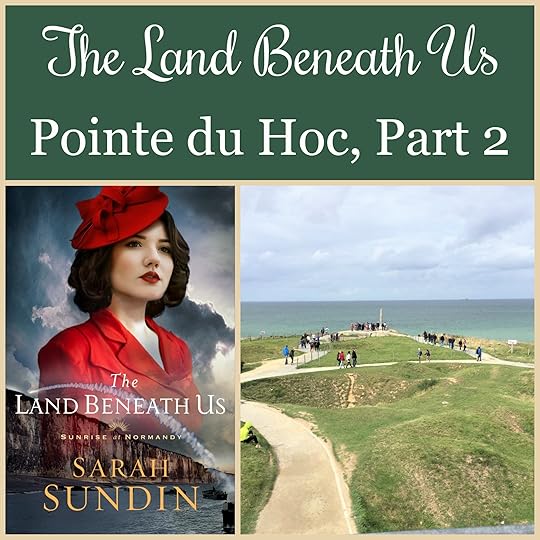
To celebrate the release of The Land Beneath Us, I’m conducting a photo tour of locations from the novel that I saw on my research trips to England, Normandy, Tennessee and more.
From the previous books in the Sunrise at Normandy series:
Tour of London Part 1
Tour of London, Part 2
Tour: D-Day at Sea (includes photos of the Isle of Wight and crossing the English Channel)
Tour of Omaha Beach
Tour of the Queen Mary (sister ship of the Queen Elizabeth)
From The Land Beneath Us:
Today—Pointe du Hoc, Part 2
Don’t forget to enter The Land Beneath Us Release Day Giveaway, which includes lots of items I picked up on the trips! Giveaway runs Feb. 4-10, 2020.
Pointe du Hoc
Please see Part 1 for the story (and pictures) of how the US 2nd Ranger Battalion landed at Pointe du Hoc in Normandy on D-day, June 6, 1944, and scaled the 100-foot cliffs under heavy fire.
At the top of the cliffs, the Rangers immediately raced in small units for their assigned objectives—the six guns arranged in a V on the point and the observation post at the tip. Here are photos of the gun casemates and open gun pits at Pointe du Hoc, a German bunker, and the observation post.

Gun casemate at Pointe du Hoc (Photo: Sarah Sundin, September 2017)

Inside a gun casemate at Pointe du Hoc (Photo: Sarah Sundin, September 2017)

Gun casemate at Pointe du Hoc (Photo: Sarah Sundin, September 2017)

Ruins at Pointe du Hoc (Photo: Sarah Sundin, September 2017)

Bunker at Pointe du Hoc (Photo: Sarah Sundin, September 2017)

Open gun pit at Pointe du Hoc (Photo: Sarah Sundin, September 2017)

Observation post at tip of Pointe du Hoc (Photo: Sarah Sundin, September 2017)

View from inside observation post at tip of Pointe du Hoc (Photo: Sarah Sundin, September 2017)
To the Rangers’ shock, they found telephone poles where the guns were supposed to be. They immediately raced for their next objective, the highway connecting Vierville to Grandcamps-les-Bains, where they were to set up a roadblock to prevent German reinforcements from reaching Omaha Beach. En route to the highway, some of the Rangers noticed tire tracks leading away from the gun positions and decided to search for the guns.
By 0815, only an hour after landing, the road and the tiny village of Au Guay were secure, and 1st Sgt. Leonard “Len” Lomell and Staff Sgt. Jack Kuhn ventured into the bocage (hedgerows) south of the highway. They found five of the guns and disabled them with thermite grenades. Word was immediately sent to Rudder. Before 0900, all the Rangers’ objectives on D-day at Pointe du Hoc had been met.

Village of Au Guay, near Pointe du Hoc (Photo: Sarah Sundin, September 2017)

Lane through the bocage (hedgerows) near Pointe du Hoc (Photo: Sarah Sundin, September 2017)

View through the bocage (hedgerows) near Pointe du Hoc (Photo: Sarah Sundin, September 2017)

View through the bocage (hedgerows) toward Au Guay, near Pointe du Hoc (Photo: Sarah Sundin, September 2017)

Model of gun at Pointe du Hoc (Photo: Sarah Sundin, September 2017)
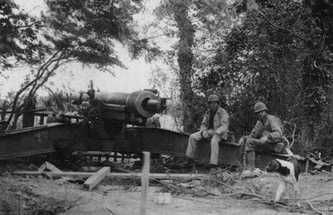
Rangers 1st Sgt. Leonard “Len” Lomell and Staff Sgt. Jack Kuhn sitting on one of the 155mm guns they found and disabled on Pointe du Hoc, June 1944 (Public domain via Battle of Normandy Tours)
For the rest of the day, they fended off minor attacks at the road and on the point. Late at night, the Germans launched counterattacks on the Rangers at the road positions, eventually driving them back to the point.
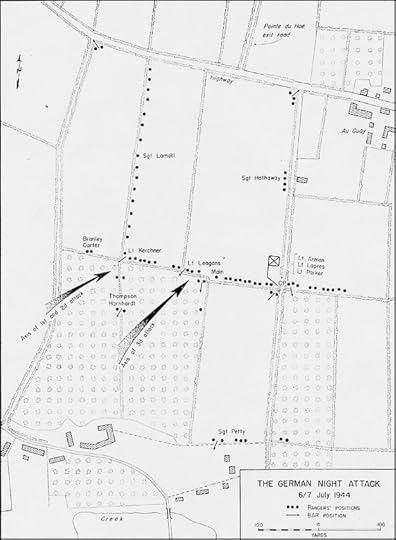
Map showing German attacks on US 2nd Ranger Battalion positions along highway near Pointe du Hoc, June 6-7, 1944 (US War Department, Historical Division)

Pointe du Hoc, D-day, 6 June 1944: Lt. Col. James Rudder’s Command Post was set in a cratered niche at the edge of the cliff. Lt. Eikner, in charge of the communications section, is near the center, drinking from his canteen (US Navy photo)
The Rangers fighting around Lt. Col. Rudder’s command post on the point held off the Germans, preventing them from moving more guns to the position. Finally on June 8, they were relieved by forces arriving from Omaha Beach. At that time, only about ninety of the original two hundred men were capable of bearing arms. In the assault on Pointe du Hoc, twenty-six Rangers were killed, twenty-three were taken prisoner, and forty-seven were wounded.

Monument to the US 2nd Ranger Battalion at Pointe du Hoc in Normandy, France (Photo: Sarah Sundin, September 2017)
Today a monument stands at the tip of Pointe du Hoc, dedicated by President Ronald Reagan on June 6, 1984, the fortieth anniversary of D-day. The men of the 2nd Ranger Battalion acted with great courage, strength, initiative, and honor on that day. They accomplished their objectives and have earned their legendary place in history.
To see more historical photos of the US 2nd Ranger Battalion in training and at Pointe du Hoc, please visit my Pinterest board.
February 6, 2020
The Land Beneath Us – Tour of Pointe du Hoc, Part 1

To celebrate the release of The Land Beneath Us, I’m conducting a photo tour of locations from the novel that I saw on my research trips to England, Normandy, Tennessee and more.
From the previous books in the Sunrise at Normandy series:
Tour of London Part 1
Tour of London, Part 2
Tour: D-Day at Sea (includes photos of the Isle of Wight and crossing the English Channel)
Tour of Omaha Beach
Tour of the Queen Mary (sister ship of the Queen Elizabeth)
From The Land Beneath Us:
Today—Pointe du Hoc, Part 1
February 7—Pointe du Hoc, Part 2
Don’t forget to enter The Land Beneath Us Release Day Giveaway, which includes lots of items I picked up on the trips! Giveaway runs Feb. 4-10, 2020.
Pointe du Hoc
The story of the US 2nd Ranger Battalion scaling the cliffs of Pointe du Hoc has fascinated many. On this steep little point of land in Normandy, the Germans had placed six 155-mm French-made guns, each with a range of ten miles, capable of reaching both Utah and Omaha Beaches as well as the invasion fleet at sea. They needed to be eliminated.

Cliffs of Pointe du Hoc (Photo: Sarah Sundin, September 2017)

Cliffs of Pointe du Hoc (Photo: Sarah Sundin, September 2017)

Tip of Pointe du Hoc (Photo: Sarah Sundin, September 2017)

Map showing Allied naval bombardment of Normandy on D-day, 6 June 1944, showing location of Pointe du Hoc (Victory in the West, vol. 1, public domain via National Archives, UK)
The US Army called on Lt. Col. James Earl Rudder and his 2nd Ranger Battalion. The Germans expected an attack from the land—not from the sea—so Rudder’s Rangers were assigned to climb the 100-foot tall cliffs and disable those guns.

Lt. Col. James Earl Rudder, commander of US 2nd Ranger Battalion, on Pointe du Hoc in Normandy, 7 June 1944 (Texas A&M Cushing Library)

Army Rangers of the US 5th Ranger Battalion in an LCA landing craft about to board their troopship for D-day, Weymouth, England, 1 June 1944 (US National Archives)
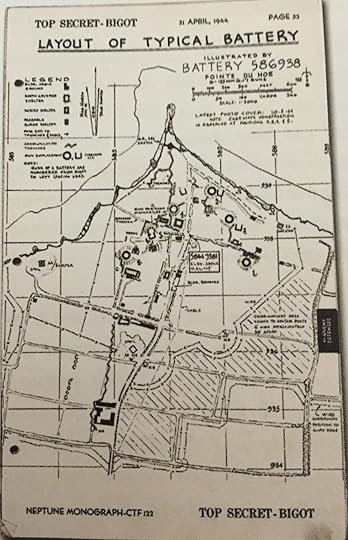
Allied map showing German gun emplacements and defenses at Pointe du Hoc, Normandy, dated 21 April 1944 and used in preparations for D-day (Imperial War Museum MH 24806)
Before D-day, the bombers of the RAF and the US Eighth and Ninth Air Forces subjected Pointe du Hoc to heavy aerial bombing. In fact, one air raid in April 1944 destroyed one of the guns. As a result, the Germans moved the remaining five guns about a mile inland and placed telephone poles in the original positions to fool Allied aerial reconnaissance. Although the French Resistance did send word of the changes, this information didn’t get to the unit before D-day. The remaining guns were still active and were trained on Utah Beach, but were not fired on D-day.
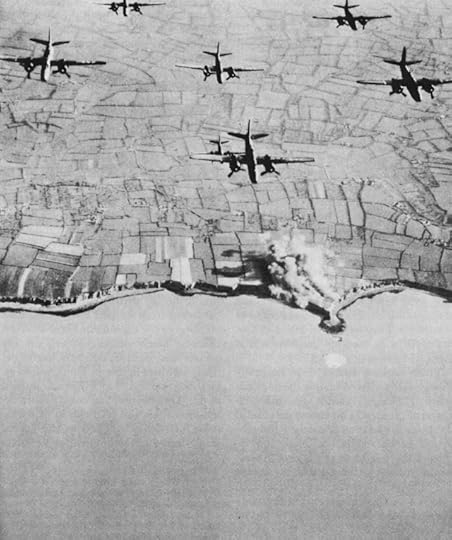
Pre-invasion Bombing of Pointe du Hoc by US Ninth Air Force A-20 light bombers, spring 1944. (US Army Center for Military History)
On June 1, 1944, the US 2nd and 5th Ranger Battalions boarded their transports in Weymouth, England. Rudder, in command of both battalions, had split the force between Omaha Beach and Pointe du Hoc. In the 2nd Ranger Battalion, companies D, E, and F were to land first. If successful, they were to signal companies A and B to land also. If they failed, companies A and B were to head to Omaha.

British Navy Landing Craft LCA-1377 carries US 5th Rangers to transport HMS Baudouin, Weymouth, England, June 1, 1944. Rangers include Lt. Stan Askin, Capt. John Raaen, Maj. Richard Sullivan, and chaplain Father Lacy, carrying medical supplies. British sailors in the conning tower (US National Archives)
Before dawn on June 6, 1944, the Rangers boarded their little LCAs (Landing Craft, Assault) from their transport ships. At 0430, they began the ten-mile trek toward Pointe du Hoc, due to land at 0630. Allied ships heavily bombarded the point from 0550-0630.
However, the coxswain of the British motor launch in the lead made a navigational error. Rudder discovered the error, and after a spirited discussion with the coxswain, convinced him to switch course—but this created a forty-minute delay, leading to a change in the landing plan.

Aerial photo marked to show the assault landings at Pointe du Hoc by the US 2nd Ranger Battalion on D-day, 6 June 1944 (US Army Air Force photo)
Due to that delay, they had to chug in parallel to the coast under heavy German fire, and they were unable to signal in time for reinforcement by companies A & B. Also, the naval bombardment ended at 0630, when the Rangers were scheduled to land. The delay allowed the Germans to come out from their underground shelters and defend the point.

Rocket-propelled grapnel used by the US 2nd Ranger Battalion at Pointe du Hoc, Pointe du Hoc Ranger Monument (Photo: Sarah Sundin, September 2017)

Rangers climbing the cliff of Pointe du Hoc on D+2 (June 8, 1944), bringing up supplies. A ladder, a toggle rope, and two plain ropes are in view ((US Navy photo #80-G-45716)
Despite these setbacks, the Rangers were trained to be flexible and to take the initiative. They fired their rocket-propelled grapnels. Since the LCAs had swamped, the ropes were wet and heavy, and only nineteen of fifty-four held. But within five minutes of landing, the first of the two hundred Rangers reached the top of the cliff. Within thirty minutes, all of the men had scaled the cliffs except a medical detachment and the wounded.
What they saw amazed them. The land was pockmarked with giant craters from the aerial and naval bombardment, and swirling with smoke. The craters served well to conceal the Rangers as they made their way to their objectives—but they also concealed the Germans.

View over Pointe du Hoc from the top of a gun battery, facing the point (Photo: Sarah Sundin, September 2017)

View over Pointe du Hoc showing cratering (Photo: Sarah Sundin, September 2017)

Crater on Pointe du Hoc (Photo: Sarah Sundin, September 2017)

One of the very few pictures showing the US 2nd Ranger Battalion in action on D-day inside a crater on Pointe du Hoc (US Navy photo)
Please return tomorrow for more photos and more of the story…
February 5, 2020
The Land Beneath Us – Tour of Tullahoma, Tennessee

To celebrate the release of The Land Beneath Us, I’m conducting a photo tour of locations from the novel that I saw on my research trips to England, Normandy, Tennessee and more.
From the previous books in the Sunrise at Normandy series:
Tour of London Part 1
Tour of London, Part 2
Tour: D-Day at Sea (includes photos of the Isle of Wight and crossing the English Channel)
Tour of Omaha Beach
Tour of the Queen Mary (sister ship of the Queen Elizabeth)
Today—Tullahoma, Tennessee
February 6—Pointe du Hoc, Part 1
February 7—Pointe du Hoc, Part 2
Don’t forget to enter The Land Beneath Us Release Day Giveaway, which includes lots of items I picked up on the trips! Giveaway runs Feb. 4-10, 2020.
Tullahoma, Tennessee
In 1940, Tullahoma, Tennessee was a small Southern town of 4500 people. That year the US Army began construction of Camp Peay, which was officially activated as an Army training camp on 10 January 1941 and renamed Camp Forrest after Confederate Gen. Nathan Bedford Forrest—not without controversy. At Camp Forrest’s peak during WWII, Tullahoma’s population swelled to 75,000, straining housing, the phone, water, and postal services, and more.
When I visited Nashville for a conference in September 2018, I took a side trip to Tullahoma to get a feel for the town. My first stop (after lunch) was at the historic Couch’s store. When I inquired whether the antique postcards by the cash register were for sale, the lovely lady behind the counter gave the traditional Southern greeting to a California girl—“You’re not from around here, are you?” I hadn’t even said “like” or “totally.” It turned out I was speaking to Candy Couch, great-granddaughter of “Daddy Billy” Couch, a Tullahoma legend, and daughter of Bob Couch, a gifted photographer and a World War II Navy veteran.
Candy showed true Southern hospitality to me. For at least an hour, she told me stories and showed me old photos and even left her store (without locking the door!) to show me photos and artifacts next door. What a treat! So much of her information made it into The Land Beneath Us, and I’m truly indebted to her.

Daddy Billy’s Restaurant and Couch’s Store on N. Atlantic St., Tullahoma, TN (Photo: Sarah Sundin, September 2018)

Candy Couch with a photo of her beloved father, Bob Couch, in the historic Couch’s store in Tullahoma, TN, September 2018 (Photo: Sarah Sundin)
Here are some views of Tullahoma’s downtown.

N. Atlantic Street, Tullahoma, TN (Photo: Sarah Sundin, September 2018)

N. Atlantic Street, Tullahoma, TN (Photo: Sarah Sundin, September 2018)

W. Lincoln St., Tullahoma, TN. Clayton’s Shoes has been in this location since 1910 (Photo: Sarah Sundin, September 2018)

This building was the post office during World War II, and is now owned by the First Christian Church (Photo: Sarah Sundin, September 2018)
Some beautiful Tullahoma churches.

First Baptist Church, Tullahoma, TN (Photo: Sarah Sundin, September 2018)

First Christian Church, Tullahoma, TN (Photo: Sarah Sundin, September 2018)
This is the train depot, which plays a pivotal role in the story. According to Candy Couch, the depot used to lie a block to the south, directly in front of the family store. However, the freight trains often blocked a major intersection, so they moved it to its current location right before World War II.

Train depot from the street side, Tullahoma, TN (Photo: Sarah Sundin, September 2018)

Train depot from the rail side, Tullahoma, TN (Photo: Sarah Sundin, September 2018)
Camp Forrest
Few of the buildings for Camp Forrest remain today, and the trees have completely taken over. Using maps, I found the locations of the library and hospital. Also, there are nice monuments to Camp Forrest and to the 2nd and 5th Ranger Battalions that trained at Camp Forrest.

At Camp Forrest site, looking down Forrest Blvd., near location of former library (Photo: Sarah Sundin, September 2018)

At Camp Forrest site, near location of former hospital (Photo: Sarah Sundin, September 2018)

Monuments to Camp Forrest and the Rangers, Tullahoma, TN (Photo: Sarah Sundin, September 2018)

Monument to Camp Forrest, Tullahoma, TN (Photo: Sarah Sundin, September 2018)

Monument to the 2nd & 5th Ranger Battalions Tullahoma, TN (Photo: Sarah Sundin, September 2018)
If you’d like to see some historical photos of Camp Forrest, please visit my Pinterest board.
If you’d like more information on Camp Forrest and life in Tullahoma during World War II, please see Elizabeth Taylor’s excellent books, Images of America: Camp Forrest (which really helped in the writing of this novel) and her brand-new book, Voices of Camp Forrest in World War II. She kindly sent me a copy, and it’s full of fascinating photos and stories!
Please come back tomorrow, when I’ll share the first group of photos from Pointe du Hoc in Normandy.
February 4, 2020
The Land Beneath Us Release Day Giveaway!

To celebrate the release of The Land Beneath Us, I’m giving away a prize pack of items I picked up in England and Normandy and Tennessee on my research trips! Come join me on Facebook Live Video on February 4, 2020 at 10 am PST/1 pm EST where I’ll describe the items and their significance to the story! The video will be available for viewing afterward as well.
Also, please join me this week on my blog for a photo tour of locations from The Land Beneath Us, including Pointe du Hoc in Normandy and Tullahoma, Tennessee!
To help you get “In the Mood” for the story, I’m giving away a package including:
Sand I collected from Omaha Beach, in a commemorative jar
Normandy souvenir tea towel
“Texas Is Calling” grocery tote bag and Texas postcard (courtesy of Carolyn Robinson)
“Beautiful Britain” note cards (courtesy of Bonnie Copland)
Playing cards with photos of D-day sites in Normandy
Commemorative D-day pen
Antique postcard from Tullahoma, Tennessee
Brochure and postcard from Pointe du Hoc
The Land Beneath Us zipper pouch

The giveaway is open February 4-10, 2020. US mailing addresses only please. The winner will be announced here on my blog on February 12, 2020.
Enter the giveaway in the Rafflecopter form below.
Today in World War II History—February 4, 1940 & 1945

Churchill, Roosevelt, and Stalin at the Livadia Palace in Yalta, USSR (now Ukraine), Feb 1945. (US National Archives: USA C-543)
80 Years Ago—February 4, 1940: Soviets execute Nikolai Yezhov, the head of the NKVD during the Great Purge in 1937-38, which was responsible for over 600,000 deaths (his execution remained secret until 1948).
75 Years Ago—Feb. 4, 1945: Yalta Conference begins—Roosevelt, Churchill, and Stalin plan the division of postwar Europe.
Allies liberate Belgium.
First Allied truck convoy over the reopened Burma Road arrives in Kunming, China.
February 3, 2020
The Land Beneath Us Photo Tour
 To celebrate the release of The Land Beneath Us, I’m conducting a photo tour of locations from the novel that I saw on my research trips to England and Normandy and to Tullahoma, Tennessee.
To celebrate the release of The Land Beneath Us, I’m conducting a photo tour of locations from the novel that I saw on my research trips to England and Normandy and to Tullahoma, Tennessee.
Today, I’m linking to photo tours I conducted for The Sea Before Us and The Sky Above Us that also relate to The Land Beneath Us. 
Tour: D-Day at Sea (includes photos of the Isle of Wight and crossing the English Channel)
Tour of the Queen Mary (sister ship of the Queen Elizabeth)
Come back later this week for The Land Beneath Us Release Day Giveaway, where I’ll be giving away items from England, Normandy, Tennessee, and Texas (coming February 4, 2020) – and for new photos relating to The Land Beneath Us!
Tour of Tullahoma, Tennessee (coming February 5, 2020)
Tour of Pointe du Hoc, part 1 (coming February 6, 2020)
Tour of Pointe du Hoc, part 2 (coming February 7, 2020)





